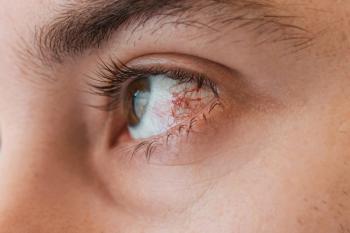
New option for peroxide lens care case
According to a recent report form the Centers for Disease Control (CDC), there are approximately 40.9 million adult wearers of contact lenses in the U.S.1 Numerous reports suggest that 16 to 31 percent of contact lens wearers discontinue contact lens wear and return to glasses.
According to a recent report form the Centers for Disease Control (CDC), there are approximately 40.9 million adult wearers of contact lenses in the U.S.1 Numerous reports suggest that 16 to 31 percent of contact lens wearers discontinue contact lens wear and return to glasses.2-5
One of the most frequent problems with those who continue to wear contact lens is low compliance with approved regimens.6-13 The recent report from the CDC states that 99 percent of wearers reported at least one contact lens hygiene risk behavior.
Nearly one third of contact lens wearers reported having experienced a previous contact lens-related red or painful eye requiring a doctor visit.1 Consumers who use multipurpose disinfection solutions (MPS) have the worst compliance with the available lens care systems.13
Additionally, biocompatibility concerns with MPS and certain silicone hydrogel lens materials persist, adding another layer of problems for MPS disinfection systems.14
Patients often discontinue use of MPS disinfection systems because of sensitivities to the chemicals in these products. For such patients, hydrogen peroxide system is the only remaining option for disinfecting their lenses. Using a hydrogen peroxide disinfection system alleviates coming into contact with the bioactive chemicals in multi-purpose solutions.
The chemicals used in MPS systems may be uptaken into lenses, reducing the antimicrobial efficacy of the solution, and may then be released onto the ocular surface during wear.15 Patients may simply stop wearing contact lenses rather than switch to a hydrogen peroxide system with its perceived complexity of use.
Related:
Neutralizing peroxide
Most hydrogen peroxide disinfection systems use a specially designed platinum disc to neutralize hydrogen peroxide. The cases supplied by manufacturers vary in the time required to neutralize and the chemistry used in the process. However, the peroxide cases used today do not “control” any aspect of the disinfection/neutralization process.
Related:
Several variables have significant impact on the sufficiency of the disinfection cycle:
• Initial concentration of peroxide used
• Rate of neutralization of the peroxide
• Residual peroxide concentration at the end of the neutralization process
Current systems rely exclusively on compliance by patients, and the user is reminded of non-compliance only by the burning and stinging upon application of the lens onto the eye.
New case better informs wearers
Today there is a new “intelligent” lens case, intelli-Case from NovaBay, for use with hydrogen peroxide disinfection systems that can help patients overcome challenges associated with use of these systems. This case can be used with both gas permeable (GP) and soft contact lenses. The case provides guidance during each step of the disinfection process as well as offers assurance to patients that their lenses are safe to wear at the end of the cycle.
Related:
Intelli-Case is designed to assure that full-strength (3%) ophthalmic peroxide is being used and will flash “unsafe” in the presence of ophthalmic hydrogen peroxide below shelf-life limits, or non-ophthalmic peroxide solution. Similarly, it prevents the user from “topping off” the solution remaining in the case to begin the next cycle. When the cycle is complete, the “ready” light will flash to indicate that minimal residual peroxide is present, thus preventing burning and stinging upon application. In addition, the case lets the user know when it is time to be replaced.
Design of intelli-Case
The intelli-Case is furnished with three indicator lights which monitor the disinfection/cleaning regimen (see Figure 1). A red light shows patients that the lenses are not safe to be worn and/or the cycle must be started over; a yellow light indicates the system is working; and a green light specifies that disinfection is complete and lenses are ready for wear.
The case is controlled by semiconductor technology as shown in Figure 2. The case is sophisticated in design but easy for the patient to use (see Figure 3).
From the beginning of the cycle, sensors measure the process of hydrogen peroxide neutralization by the platinum catalyst. The neutralization process produces heat by an exothermic reaction. The system measures the rise in temperature (rate of neutralization) and assures it is in the range designed for the solution supplied with the case.
The rates of this reaction are very predictable within a wide range of ambient temperatures in which peroxide care systems may be used from 40 degrees F to 104 degrees F (5 degrees C to 40 degrees C). During the entire neutralization process, the case will indicate that it is working by flashing the yellow “busy” light.
Related:
If a patient uses an inadequate solution-for example, saline, generic non-ophthalmic peroxide or previously neutralized solution-or tops off the residual solution in the case, the red “unsafe” light will blink, letting the user know that adequate disinfection is not possible and the user must start over. When the neutralization is complete, the green “safe” light blinks to announce the lenses are disinfected and safe to wear.
Over time, the platinum catalyst becomes “fouled” by tear components and biofilm. Such fouling puts patients at risk for irritation or microbe transfer to the eye. With current peroxide cases, there is no way to know that the catalyst has become fouled, resulting in burning and stinging when lenses are applied.
With standard cases, it is discomfort that generally triggers the patient to replace the lens case. If the catalyst becomes fouled during normal use of intelli-Case, such that it cannot provide adequate neutralization of the peroxide, the red “unsafe” light will blink to warn of an unsafe condition.
To prevent fouling of the platinum disc at dangerous levels, intelli-Case is deactivated after 65 cycles of use, indicated by continuous blinking of the red light, thus preventing the further use of the case. After 60 cycles of disinfection, intelli-Case signals the user that the case needs to be replaced soon by blinking all three lights, red, yellow, and green, when the cap is removed following completion of the 60th to 65th cycle.
The U.S. Food and Drug Administration (FDA) approved intelli-Case earlier this year. Marketing support studies have begun, and the company is planning to introduce intelli-Case into selective markets by the end of 2015.
References
1. Cope J, Collier S, Rao M, Chalmers R, Mitchell G, Richdale K, Wagner H, Kinoshiita B, Lam D, Sorbara L, Zimmerman A, Yoder J, Beach M. Contact Lens Wearer Demographics and Risk Behaviors for Contact Lens-Related Eye Infections – United States 2014. MMWR 2015 Aug; 64(32):865-870.
2. Rumpakis J. New Data on Contact Lens Dropouts: An International Perspective. Rev Optometry. Available at: http://www.revoptom.com/content/d/contact_lenses_and_solutions/c/18929/. Accessed 09/08/2015.
3. Evans VE, Carnt NA, Naduvilath TJ, Holden BA. Factors associated with drop out from silicone hydrogel contact lens daily wear. Invest Ophthalmol Vis Sci. 2008; 49:E-Abstract 4839.
4. Young G, Veys J, Pritchard N, Coleman S. A multi-centre study of lapsed contact lens wearers. Ophthalmic Physiol Opt. 2002 Nov;22(6):516-27.
5. Richdale K, Sinnott LT, Skadahl E, Nichols JJ. Frequency of and factors associated with contact lens dissatisfaction and discontinuation. Cornea. 2007 Feb;26(2):168-74.
6. Collins MJ, Carney LG. Patient compliance and its influence on contact lens wear problems. Am J Optom Physiol Opt. 1986 Dec;63(12):952-6.
7. Claydon BE, Efron N. Non-compliance in contact lens wear. Ophthalmic Physiol Opt. 1994 Oct;14(4):356-64. Review.
8. Donshik PC, Ehlers WH, Anderson LD, Suchecki JK. Strategies to better engage, educate, and empower patient compliance and safe lens wear: compliance: what we know, what we do not know, and what we need to know. Eye Contact Lens. 2007 Nov;33(6 Pt 2):430-3; discussion 434.
9. Efron N. The truth about compliance. Cont Lens Anterior Eye. 1997;20(3):79-86.
10. Robertson DM, Cavanaugh HD. Non-compliance with contact lens wear and care practices: a comparative analysis. Optom Vis Sci. 2011 Dec;88(12):1402-8.
11. de Oliveira PR, Temporini-Nastari ER, Ruiz Alves M, Kara-Jose N. Self-evaluation of contact lens wearing and care by college students and health care workers. Eye Contact Lens. 2003 Jul;29(3):164-7.
12. Morgan P. Contact lens compliance and reducing the risk of keratitis. Optician. 2007 Jul 6. Available at: https://s3-eu-west-1.amazonaws.com/rbi-communities/wp-content/uploads/importedimages/morgan.pdf. Accessed 09/08/2015.
13. Doubleton KA, Woods J, Woods CA, Fonn D. Compliance with current lens care regimens. OVS 2007; 84: e-abstract 070087.
14. Jones L, MacDougall N, Sorbara LG. Asymptomatic corneal staining associated with the use of balafilcon silicone-hydrogel contact lenses disinfected with a polyaminopropyl biguanide-preserved care regimen. Optom Vis Sci. 2002 Dec;79(12):753-61.
15. Mowrey-Mckee M, Borazjani, R, Collins G, Cook J, Norton S. A new method for evaluation of compatibility of contact lenses and lens cases with contact lens disinfecting solutions. Eye Contact Lens. 2012 Jan;38(1):53-62.
Newsletter
Want more insights like this? Subscribe to Optometry Times and get clinical pearls and practice tips delivered straight to your inbox.



















































.png)


